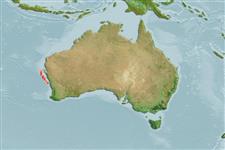Actinopterygii (ray-finned fishes) >
Gadiformes (Cods) >
Macrouridae (Grenadiers or rattails) > Macrourinae
Etymology: Nezumia: A Japanese word that means "mouse" . More on author: Iwamoto.
Environment / Climate / Range
Ecology
Marine; bathydemersal; depth range 688 - 854 m (Ref. 35909). Deep-water, preferred ?; 26°S - 30°S
Distribution
Countries | FAO areas | Ecosystems | Occurrences | Point map | Introductions | Faunafri
Eastern Indian Ocean: known only from Western Australia.
Size / Weight / Age
Maturity: Lm ? range ? - ? cm
Max length : 23.0 cm TL male/unsexed; (Ref. 35909)
Short description
Morphology | Morphometrics
Dorsal
spines
(total): 2;
Anal
spines: 0. pelvic fin rays 11-12; height first dorsal less than head length; underside of head including lower jaw naked, without prominent sensory pores; scales covered with tiny spinules in parallel to slightly convergent rows; 10-11 scale rows below origin of second dorsal fin, about 50 lateral line scales from anterior origin over distance equal to predorsal length; dark color of trunk confined to abdomen, not extending onto dorsum; first dorsal fin pale with blackish tip; anterior dermal window of light organ small, situated between pelvic fin bases; tip of tail distinctly pale over posterior 1/4-1/5th of fin, from about 90th anal ray. Snout protruding, angular.
A benthic species found on the continental slope (Ref. 75154).
Life cycle and mating behavior
Maturity | Reproduction | Spawning | Eggs | Fecundity | Larvae
Iwamoto, T. and A. Williams, 1999. Grenadiers (Pisces, Gadiformes) from the continental slope of western and northwestern Australia. Proc. Calif. Acad. Sci. 51(3):105-243. (Ref. 35909)
IUCN Red List Status (Ref. 115185)
CITES (Ref. 94142)
Not Evaluated
Threat to humans
Harmless
Human uses
More information
CountriesFAO areasEcosystemsOccurrencesIntroductionsStocksEcologyDietFood itemsFood consumptionRation
Common namesSynonymsMetabolismPredatorsEcotoxicologyReproductionMaturitySpawningFecundityEggsEgg development
Age/SizeGrowthLength-weightLength-lengthLength-frequenciesMorphometricsMorphologyLarvaeLarval dynamicsRecruitmentAbundance
ReferencesAquacultureAquaculture profileStrainsGeneticsAllele frequenciesHeritabilityDiseasesProcessingMass conversion
Tools
Special reports
Download XML
Internet sources
Estimates of some properties based on models
Phylogenetic diversity index (Ref.
82805): PD
50 = 0.5000 [Uniqueness, from 0.5 = low to 2.0 = high].
Bayesian length-weight: a=0.00219 (0.00097 - 0.00495), b=3.17 (2.98 - 3.36), in cm Total Length, based on LWR estimates for this (Sub)family-body shape (Ref.
93245).
Trophic Level (Ref.
69278): 3.3 ±0.1 se; Based on size and trophs of closest relatives
Resilience (Ref.
69278): Medium, minimum population doubling time 1.4 - 4.4 years (Preliminary K or Fecundity.).
Vulnerability (Ref.
59153): Low to moderate vulnerability (31 of 100) .
